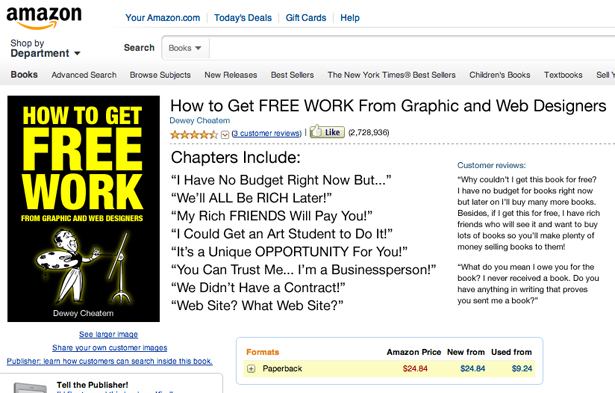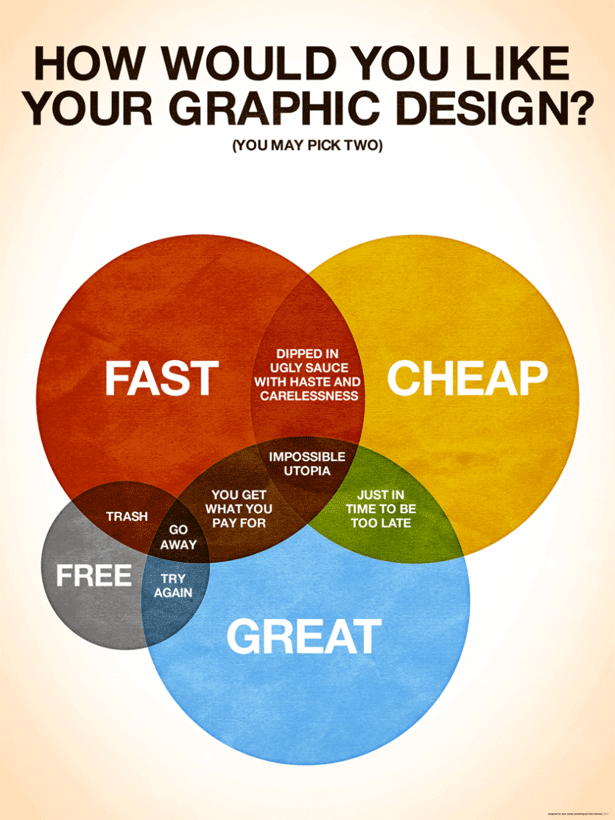 A former coworker of mine, James Harmon, is a bright and very talented designer with experience in some top corporations. He recently posted on Facebook a quote of his own thinking:
“In life, everyone cuts their own deal. The trick is not cutting one's own throat in the process.”
I told him that I needed to steal that for an article. It sums up the whole problem designers face when the question of doing free work pops up, as it does, no matter how experienced you may be. After a couple of decades in the creative field, I still get a disturbing number of requests for free work – more now then when I was a young designer entering the field. Why? People want quality but they don’t want to pay for it.
It’s funny that our consumer habits have us shopping daily for bargains – cheap merchandise that lasts a few months as opposed to something of quality that will last years. Money has clouded judgment when it comes arto seeing value — true value.
As one comedian once said, “does anyone else get nervous flying on a plane that was built by the lowest bidder?”
A former coworker of mine, James Harmon, is a bright and very talented designer with experience in some top corporations. He recently posted on Facebook a quote of his own thinking:
“In life, everyone cuts their own deal. The trick is not cutting one's own throat in the process.”
I told him that I needed to steal that for an article. It sums up the whole problem designers face when the question of doing free work pops up, as it does, no matter how experienced you may be. After a couple of decades in the creative field, I still get a disturbing number of requests for free work – more now then when I was a young designer entering the field. Why? People want quality but they don’t want to pay for it.
It’s funny that our consumer habits have us shopping daily for bargains – cheap merchandise that lasts a few months as opposed to something of quality that will last years. Money has clouded judgment when it comes arto seeing value — true value.
As one comedian once said, “does anyone else get nervous flying on a plane that was built by the lowest bidder?”
The old story
You’ve heard many reasons a client has for demanding free work.“There will be plenty of money LATER!” “We’ll consider you our ‘in-house’ designer once business gets going.” “I have rich friends who’ll see your work and hire you for big bucks!” “This is a great opportunity for you” (they never say why). “You can put this in your portfolio!”In an April Fool’s piece for Web Designer Depot, I created fake stories dealing with the web and design field. One of those was this fake Amazon posting.
 I guess the subject of free work is so prevalent that no one saw the piece as being fake.
In a recent discussion on a design group on LinkedIn, one designer posted the question:
“Why does everyone expect you to ‘help’ them out for FREE?”
She continued her posting with the following statement:
I guess the subject of free work is so prevalent that no one saw the piece as being fake.
In a recent discussion on a design group on LinkedIn, one designer posted the question:
“Why does everyone expect you to ‘help’ them out for FREE?”
She continued her posting with the following statement:
I am so busy with projects these days that I barely have time to empty the dishwasher. I work for myself and I love what I do. However, when friends and acquaintances point out how talented I am as a graphic designer and how successful they "know" I'm going to be (as though it's only been a hobby for the past 12 years) bla bla bla...THEN at some point down the road, nearly every single person I know has asked me to “help” them out with a project. Kids birthday invites, a work brochure, even a website...as though phrasing it in such a manner makes it any less work for me. I know what they really want is a the same service as my paying clients recite, only they want it for FREE, or "at cost," when printed products are involved or they want some elaborate custom creation that they plan to ruin by printing out on their inkjet at home. I can't tell you how many people over the years have seemingly promised my design services to their boss, their sister, their child's school...in exchange for "telling everyone" about me. REALLY? Here I spend 45 minutes or so on the phone taking notes to gain a scope of the project, only to hear, "yeah so my boss is trying to not really spend any money on this project..." and/or "can you tell me/show me how to do _______?" It's complete madness! I have even gone as far as creating a DBA (Doing Business As) so I'm operating under a business name, thinking it might discourage this entitled behavior. It has helped some, but for some, I'm still just another "connection" that is going to hook up my "friends" and their friends...and their friends' friends. I do wholeheartedly enjoy lending a helping hand whenever I can. But I also have bills to pay. I sincerely believe this entitlement syndrome is, in some sense, a general oblivion to the graphic design industry. That since it "only" involves time and not always a tangible product that, it should come at minimal or no cost because they assume I have "free time" in which I'll happily do this favor for them. How do you cordially explain to a friend or acquaintance that your time is, in fact, more valuable then they are willing to acknowledge. I don't ALWAYS oblige, but always feel guilty. I suppose I just need more of a backbone. Of course they always say they're going to send lots of business my way if I "help" them out. And in some instances, that can work well. But too few and too far between. I just despise being asked to "whip something up."Several designers chimed in with their experiences in this arena. Actually, over two dozen added their voices, most of which told the exact same stories. David M. imparted, “I usually don't mind working for family for free, but I usually try to keep the art direction to a minimum and they definitely pay for any production costs. As for friends, I just ask, ‘would I do anything for them, and would they do anything for me?’ Yes yields a yes, but again with limited ‘art direction.’ When someone busts out the ‘good for your portfolio, or will get you paid work,’ I usually tell them that my portfolio is pretty full of paid-for jobs. If they are so sure that I will get other work, perhaps they can bring in 5 new pay jobs for me and I will give them a commission for one free job of a value equal to the most expensive one they referred.” “Now if a friend comes to me and asks for help without any promises and needs it, they get my help every time. Of course I expect the same in return. By the way, paying customers burn you often as well.” Lena S. added, “Just remember, saying ‘no’ (in whatever fashion you choose) doesn't have to be mean. You can be very nice when you do it. No does not equal mean.” Lena lists some answers she has lined up for the most common requests for free work:
"I'm booked for the next two months with client work. Can you ask me again then?" "I'd love to work on your project! Just send me the specs and I'll get back to you with an estimate." "No." Just laugh. If it is really something absurd you can just throw back your head and laugh and act like you thought it was a joke. This normally stops them in their tracks. They know you heard them and now they are embarrassed or confused. When you hear something along the lines of "I can't afford to pay for this" I say, "Oh, I totally understand. I wish I could do all my client's work for free, but unfortunately, I have to pay bills too." "I do donate time to charity, but I've used all my allocated hours already this quarter. But, if you'll put it in writing I can consider you for next quarter". This is advice I got from one of my business owner friends. She decides ahead of time how many hours she will donate a year and keeps up with it. It allows you to give away some work if you want to, but keep track of it. Probably my biggest pet peeve is being told how I should illustrate their children's book for free because they are going to be famous one day and it would be really great exposure for me. I have been asked this a dozen times over the years. It's amazing that people would actually ask this. My second biggest peeve is "I'll pay you when I'm successful". I did a few of these early in my career. I never got paid, even once. Big surprise.Lena certainly covers some terrific comebacks. I added a quick response, too:
“As I tell students, people ask for free work because they are either jerks who want something for free or they just believe what you do is so fun that you don't care about money. You have certain hard costs to cover when doing free work (i.e. electricity, software purchase and upgrades, paper, printer ink, internet, etc.). When someone asks you to for free work, smile and say you'd be happy to help them out if they cover your hard costs and quote them a price of a couple hundred dollars. When they act shocked, remind them the same costs I've outlined. Chances are they will: Tell you, "never mind." Question the costs as not being that much. Explain to them how much CS6 costs. Tell you an art student will do it for free (then tell them, "that's great! Glad you have someone to do that for you because I'm really swamped with work"). Never speak to you again, which means they aren't really your friends.When you believe there's no way out of doing it for them, ask them to do some free work for you, too. I had "new friend" ask for a huge project for free and I smiled and replied I would be happy to do it. Then I said, "you know, I was going to ask if you could handle some legal matters for me (she was a lawyer). She said she was too busy. I responded that I understood and told her I would have the project done in three or four months. She couldn't wait that long and dropped the request. The old triad of design is cheap, good and fast. You may pick just two (cheap and good = takes time. Cheap and fast = crappy.) The problem is, people want all three.
 ©Colin Harmon
Lifted from an article:
©Colin Harmon
Lifted from an article:
Steve Jobs was interviewed about working with Paul Rand and asked Rand if he would come up with a few options, and he said, “no, I will solve your problem for you and you will pay me. You don’t have to use the solution. If you want options go talk to other people.”Well, Paul Rand can get away with that as a dozen other clients were pulled up in front of his studio with dump trucks filled with money but what can other designers do? The easy answer is to not supply free professional work!
Why it happens
As we grow up, we are surrounded by the stigma that we were the “weird kids” who drew pictures in our notebooks instead of paying attention in class. Our peers look at us as “free spirits” and therefore “free” comes into play. We’re not good businesspeople, very smart or worth any consideration. When we break their pre-conceived notions by being businesspeople, they turn very angry. Another major reason is that people are just greedy. They will shop around for a plumber, car, proctologist and any other service or product until they find the cheapest one they can. Good luck with that back-alley, discount proctologist, folks! ©GL Stock Images
They also know that in a worst-case scenario, they CAN get an art student to do their work for free. Don’t argue quality with them because they don’t care. They don’t know the implications of branding and what a bad logo can do to their business. If presidential candidate, Mitt Romney could promote his recent app misspelling debacle and it’s just dismissed as “not really being of any consequence,” then what chance does a really bad logo have of garnering any attention from the layperson?
Art students DO free work! If teachers stopped telling students they need printed pieces or live web sites in their portfolios to get further work, then part of the problem would go away. The truth about having a strong portfolio is not in the number of “professional pieces” (and free work rarely come out as finished pieces you would even WANT to show to a prospective client) but in the thought process behind the design. As my friend Alex, Design Director at Disney Publishing once imparted for an article on portfolios:
©GL Stock Images
They also know that in a worst-case scenario, they CAN get an art student to do their work for free. Don’t argue quality with them because they don’t care. They don’t know the implications of branding and what a bad logo can do to their business. If presidential candidate, Mitt Romney could promote his recent app misspelling debacle and it’s just dismissed as “not really being of any consequence,” then what chance does a really bad logo have of garnering any attention from the layperson?
Art students DO free work! If teachers stopped telling students they need printed pieces or live web sites in their portfolios to get further work, then part of the problem would go away. The truth about having a strong portfolio is not in the number of “professional pieces” (and free work rarely come out as finished pieces you would even WANT to show to a prospective client) but in the thought process behind the design. As my friend Alex, Design Director at Disney Publishing once imparted for an article on portfolios:
In brief, I look for diversification. I like to see that someone can work with innovative type treatments, as well as being able to make bulleted lists appealing. They should show an ability to frame up large amounts information in a clean and easy to follow layout, as well as working with only an image and headline. Most importantly, they should work with a sense of information architecture… It doesn’t matter if something looks good if it doesn’t visually convey the message or the needs of the project.Another voice opting for the strength of thought process over actual samples, stepped on by committees and clients who “know design,” is my friend Gary, Former Head of Creative Services for Cartoon Network. Gary imparts:
Customize your portfolio for the job you are applying for. If you are trying to get a design or illustration job at a specific company, then focus on showing work that relates to the type of things that the company specializes in. Do research on the company that you are interviewing with. Know what they do and who their clients are. Only show your very best work. Better to have fewer great pieces than many average pieces of work. I know it’s tempting to show a lot of stuff in order to show off your versatility, but if the work is mediocre, it won’t do you any good. Be able the talk though your thought process for each example you have in you portfolio. Be ready to talk about why you made the design and creative choices that you did. But also, in the interview, read your interviewer, he or she may not want to hear the full story about every single piece.
 ©GL Stock Images
The truth is that people who ask for free work are interested in three things: If you have the right software, if you’ll do it for free and how quickly you’ll follow all of their directions. Try this little experiment and then post how it went in the comments section. Printout the WORST logos, web sites and layouts you an find on the web. When someone contacts you about doing a project for free, agree and make an appointment for them to see your portfolio. One of two things will happen:
©GL Stock Images
The truth is that people who ask for free work are interested in three things: If you have the right software, if you’ll do it for free and how quickly you’ll follow all of their directions. Try this little experiment and then post how it went in the comments section. Printout the WORST logos, web sites and layouts you an find on the web. When someone contacts you about doing a project for free, agree and make an appointment for them to see your portfolio. One of two things will happen:
They will tell you it’s not necessary They will flip quickly through your portfolio and then explain the assignment to you.You then have two choices:
Point and laugh at them and reveal that you printed out pieces from “The Worst of _______ web site. Take the assignment and make it the worst thing you could ever design. Really screw it up!
Be charitable and a friend
A friend is a friend and sometimes they need a favor. I’ve done logos, web sites, complete company branding and business cards for friends because, as they say, “a good friend will help you move; a true friend will help you move the bodies!” ©GL Stock Images
As for charities, I’ve also done my share of those freebies. Unfortunately, they have never worked out. The one rule I always put forth for charitable work is that I do one version and that’s what they get. They asked me to do the work because I am a professional, so they need to trust my professional ability. The evil part is when someone on the board of directors or one of the elders with time on his/her hands wants to play art director so they can boast to their friends about how they “designed the web site,” is when I have to walk away. I’ve done plenty of walking while the charity finds an art student to design the work for free.
©GL Stock Images
As for charities, I’ve also done my share of those freebies. Unfortunately, they have never worked out. The one rule I always put forth for charitable work is that I do one version and that’s what they get. They asked me to do the work because I am a professional, so they need to trust my professional ability. The evil part is when someone on the board of directors or one of the elders with time on his/her hands wants to play art director so they can boast to their friends about how they “designed the web site,” is when I have to walk away. I’ve done plenty of walking while the charity finds an art student to design the work for free.
If I can give some good parting advice when I come to free work: Say “no” when it comes to doing work for a business. Tell your friends, no problem” but you need time to fit it around your business schedule. Cover your hard costs or the free job ends up costing you time AND money. Learn this infographic. Read this blog entry that doesn’t pull any punches!When it comes to free or cheap work, make it clear that you will do the best possible solution and that’s what will be delivered. What you’ll get is a professional piece/site that shows YOUR thought and design process. If the client turns it down, at least you have a strong portfolio piece!
 ©GL Stock Images
If you teach or speak to groups of students, tell them to read this article and STOP DOING FREE WORK. They’re just chipping away at the industry that they will rely upon for their future living. Free now will equal free later.
©GL Stock Images
If you teach or speak to groups of students, tell them to read this article and STOP DOING FREE WORK. They’re just chipping away at the industry that they will rely upon for their future living. Free now will equal free later.
Speider Schneider
Speider Schneider is a former member of The Usual Gang of Idiots at MAD Magazine and has designed products for Disney/Pixar, Warner Bros., Harley-Davidson, ESPN, Mattel, DC and Marvel Comics, Cartoon Network and Nickelodeon among other notable companies. Speider is a former member of the board for the Graphic Artists Guild, co-chair of the GAG Professional Practices Committee and a former board member of the Society of Illustrators. Follow him on Twitter @speider or add him on Google+
Read Next
15 Best New Fonts, July 2024
Welcome to our monthly roundup of the best fonts we’ve found online in the last four weeks. This month, there are fewer…
By Ben Moss
20 Best New Websites, July 2024
Welcome to July’s round up of websites to inspire you. This month’s collection ranges from the most stripped-back…
Top 7 WordPress Plugins for 2024: Enhance Your Site's Performance
WordPress is a hands-down favorite of website designers and developers. Renowned for its flexibility and ease of use,…
By WDD Staff
Exciting New Tools for Designers, July 2024
Welcome to this July’s collection of tools, gathered from around the web over the past month. We hope you’ll find…
3 Essential Design Trends, July 2024
Add some summer sizzle to your design projects with trendy website elements. Learn what's trending and how to use these…
15 Best New Fonts, June 2024
Welcome to our roundup of the best new fonts we’ve found online in the last month. This month, there are notably fewer…
By Ben Moss
20 Best New Websites, June 2024
Arranging content in an easily accessible way is the backbone of any user-friendly website. A good website will present…
Exciting New Tools for Designers, June 2024
In this month’s roundup of the best tools for web designers and developers, we’ll explore a range of new and noteworthy…
3 Essential Design Trends, June 2024
Summer is off to a fun start with some highly dramatic website design trends showing up in projects. Let's dive in!
15 Best New Fonts, May 2024
In this month’s edition, there are lots of historically-inspired typefaces, more of the growing trend for French…
By Ben Moss
How to Reduce The Carbon Footprint of Your Website
On average, a web page produces 4.61 grams of CO2 for every page view; for whole sites, that amounts to hundreds of KG…
By Simon Sterne
20 Best New Websites, May 2024
Welcome to May’s compilation of the best sites on the web. This month we’re focused on color for younger humans,…














